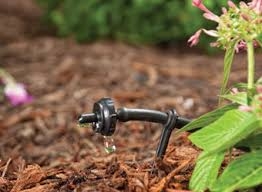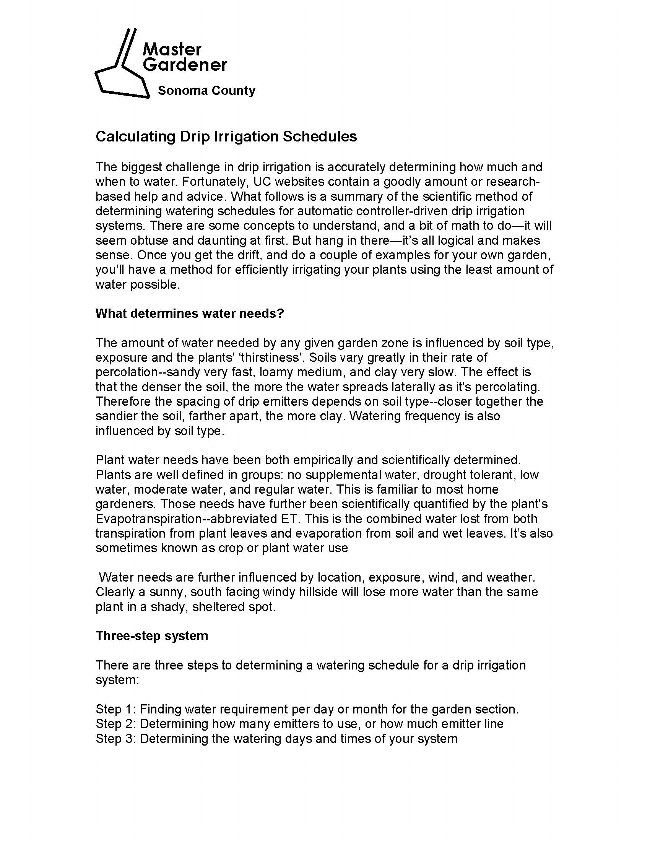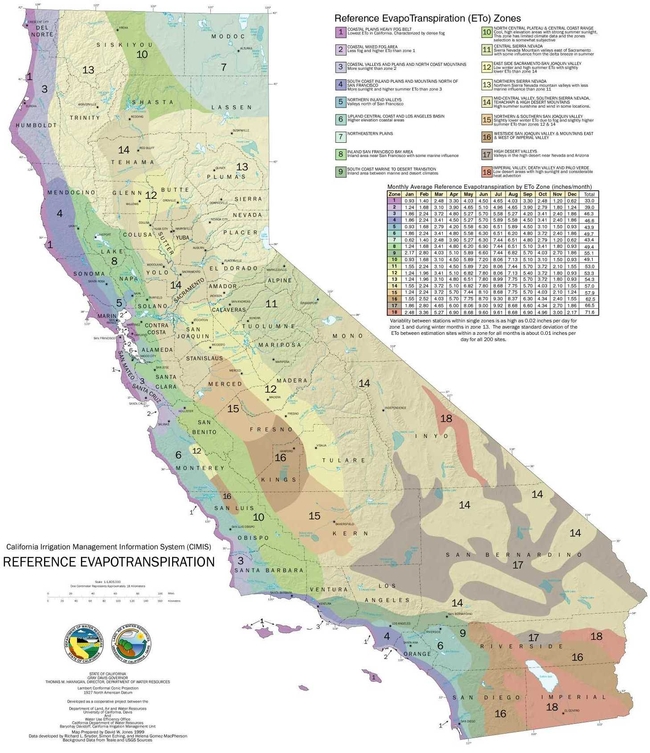Advice from the Help Desk of the Master Gardeners of Contra Costa
Client: I've recently bought to a 10 year old home in Walnut Creek. It has an established garden. A large part of the garden consists of azaleas, camellias, and rhododendrons. They are currently watered by hand. I like these plants, but I would also like to convert that part of the garden to drip irrigation to possibly be more efficient with my water and as my time is somewhat limited by other family activities. Could you please give me some guidance on how to set up a drip system for this part of my landscape.
MGCC Help Desk Response and Advice: We are writing to you to provide some information about the watering needs for your landscape, specifically your azaleas, camellias, and rhodedendrons. With the process described below and with appropriate modifications, it could apply to setting up drip irriagion to any part of your landscape.
We've tried unsuccessfully to reach you by phone several times to obtain some additional information that would affect the water requirements. Since we've been unable to connect with you by phone, we are writing to give you some preliminary general guidance about the water needs of your plants and suggestions for how you might want to set up a new drip system. If you have further questions after reviewing the information provided below, you are welcome to contact us again.
The amount of water needed in a garden landscape is influenced by many different factors such as soil type, sun and wind exposure, the plants' “thirstiness” level, plant density in the garden, plant maturity and weather conditions.
I understand that the primary plant varieties in your landscape for consideration are azaleas, camellias and rhododendrons. Each of these plant types are classified as “moderate” water need plants (see WUCOLS link at end). I have assumed for purposes of the water need calculations that the plants are well established in your landscape (i. e. , they have not been only recently planted). I have also assumed that you do not have ground covers or other dense plantings around the shrubs that would compete with the plants for water.
Since you live in Walnut Creek where clay soils are common, I have assumed that your primary soil type is clay. I have also assumed, however, that you have reasonably good drainage around the plants. Because azaleas, camellias and rhododendrons all grow best in areas outside of direct strong sunlight (i.e. , in filtered sun areas), I have assumed that those conditions exist in your garden area. I have also assumed that the plant are in a somewhat protected area in which they would have some protection from strong winds.
If my assumptions about the growing conditions for your plants are incorrect, it would affect the water needs for the plants. In that case you may want to contact us again, so we can discuss adjusting the calculations to reflect the actual growing conditions in your garden.
Drip Irrigation Calculation Guidance
If you look at the Sonoma guide, you will find a formula at the bottom of page 3 that shows how to calculate the water needs for a garden. That is the formula that I used for calculating the water needs for your shrubs. Because I did not know the total size of the landscaped area that you will be watering with your drip system, I have calculated the water needs of only a single mature shrub of the types you are growing. Before giving you the results of my calculations, let me explain a few of the terms used in the formula.

Another important variable for calculating water needs is the “Water Use Classification” of the plants you are watering (referred to as the “crop coefficient” in the Sonoma County Guide). In the case of your azaleas, camellias and rhododendrons, the plants are considered “Moderate” water use plants so the “crop coefficient” to be used in the formula is someplace between 0.4 and 0.6. For purposes of my calculations, I have used the midpoint of this range (0.5).
Based on the ETo for Walnut Creek and the “crop coefficient” of 0.5 for your shrubs and using the assumptions for your growing conditions explained above, I have calculated that each of your shrubs will need about 12.85 gallons of water during July (or roughly 3 gallons per week). Because the ETo declines in cooler months, by September. the water need would drop to about 9 gallons per plant per month (or just a little more than 2 gallons per week) and by November, the water need would decline to 3. 2 gallons per month (less than a gallon per week).
One of the questions you asked when you contacted our office was whether it would be better to use 1 GPH drippers or 2 GPH drippers. If I am correct that your predominant soil type is clay but that you have reasonably good drainage, you could use either flow rate. (If drainage is slower than I have assumed, you may be better off with the 1 GPH rate to allow the emitted water to absorb more slowly into the ground without producing run off).
Based on these calculations, if you place three 1 GPH drippers around each of the shrubs, in July you would need to run the trip system for one hour per week. You could either apply all the water once a week or could spread it over two water days per week. If instead you use three 2 GPH drippers, you could run the system half as long. And if you use fewer than 3 drippers per plant, you can adjust the water time accordingly.
As temperatures drop in future months, you'll want to periodically reduce the length of time (and therefore the gallons) the system runs. Most gardeners usually make monthly changes. Most controllers have percentage settings so that , for example, if you consider (and set) July as 100%, then, again for example, come September the controller would be set to 80%.
These calculations only produce a “starting point” for setting up your system. In particularly hot spells, you may need to increase run times and in unusually cool periods, you can reduce the run time. You should also pay attention to how the plants are performing to “tweak” the controller to your specific micro climate. You might also want to invest in a water probe so that you can periodically check to see how damp the soil is in the root area of your shrubs. Based on what you are observing about the health of the plants and the moisture level in the root zone, you can adjust the watering schedule accordingly.
I hope that you find this information to be helpful. You are welcome to contact us again if you have questions or if adjustments to our assumptions need to be made to more accurately reflect the growing conditions in your landscape.
|
Note: Promised updated links to be substituted for those in the Sonoma guide: |
Master Gardeners of Contra Costa Help Desk
Note: The Master Gardeners of Contra Costa's Help Desk is available year-round to answer your gardening questions. Except for a few holidays, we're open every week, Monday through Thursday for walk-ins from 9:00 am to Noon at 75 Santa Barbara Road, 2d Floor, Pleasant Hill, CA 94523. We can also be reached via telephone: (925) 646-6586, email: ccmg@ucanr.edu, or on the web at http://ccmg.ucanr.edu/Ask_Us/